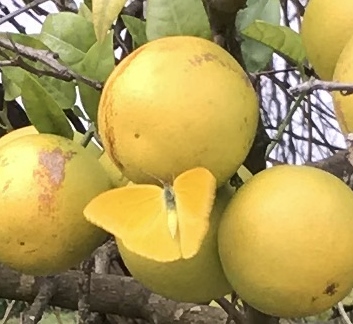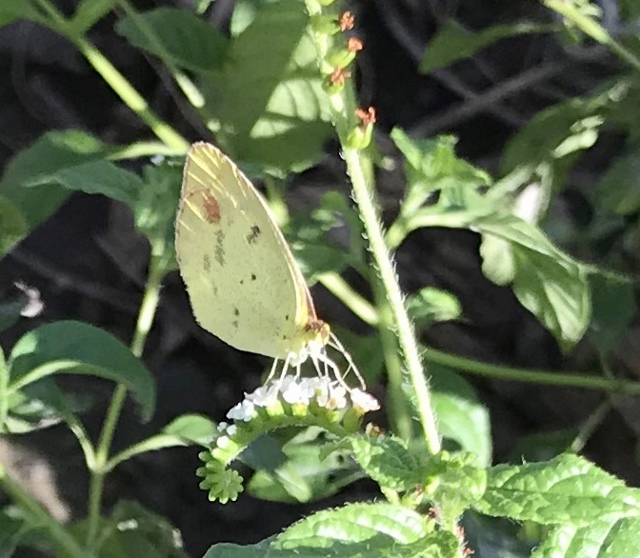

Big and little yellow butterflies fill the sky
By Anita Westervelt, Texas Master Naturalist
Sunshine, warm days, butterflies. What more could one ask of a perfect late fall Valley day?
The ever faithful big yellow butterflies are out in numbers, commanding attention as they flash their bright yellow wings. These mid-sized beauties are year-round residents of southern Texas. They are the Phoebis, or sulphurs.
Appropriately named Little Yellow butterflies also are in abundance, although not as flashy, bright or big. These are categorized as small sulphurs. Perching on tiny blooms, with wings closed, each Little Yellow could fit on a nickel.
Identifying butterflies using field guides involves a close look at marks on the butterfly wings. Among the Little Yellow’s numerous tell-tale marks, the most noticeable is a pink to cinnamon colored spot at the hindwing upper angle apex.
Other identifiers are the pinkish fringe at the edges of the wings and the two tiny black dots at the base of the hindwing. These two dots distinguish Little Yellow from two other small sulphurs, the Mimosa Yellow and the Barred Yellow. Little Yellow is common in the Valley; the Mimosa and Barred small sulphurs are just at the top of their northern range and not quite so prevalent in the Valley.
Little Yellows fly a direct path and close to the ground. The big yellows fly high with a somewhat erratic flight pattern offering loop-de-loops and other aerobatic maneuvers.
Some references say that adult big sulphurs are attracted primarily to red, orange, and purple colors. That may be. While the big yellows head toward the orange grove and native plants with larger flowers like red-blooming Turk’s cap, (Malvaviscus drummondii); orange and yellow Texas lantana (Lantana urticoides); and purple, fall blooming mist flower (crucita, Chromolaena odorata), the Little Yellow is happy to stick around the tiny white flowers of heliotrope, Heliotropium angiospermum.
Heliotrope is an all-time excellent, native nectar plant. It blooms in all seasons providing nectar for resident butterflies all year. It generally attracts the smaller butterflies like duskywings, metalmarks, blues, checkerspots and white peacocks. Also called scorpion’s tail, the tip of the flower stalk arches similar to the tail of a scorpion.
Three of the big yellow butterflies you may be seeing flitting around colorful late fall blooms are the Cloudless Sulphur, Phoebis sennae, Large Orange Sulphur, Phoebis agarithe, and the Orange-barred Sulphur, Phoebis philea.
The Cloudless Sulphur is the paler yellow of the three with more distinguishing marks and a rim of brown wing fringe. It measures nearly two inches from top of forewing to bottom of hindwing when perching.
The Large Orange Sulphur is a deep yellow and the Orange-barred Sulphur, an even deeper yellow.
The Orange-barred Sulphur is the largest of these three and although recognized as uncommon in Texas, it is a regular here in extreme south Texas. The male of the species has broad orange bars on the hind wings that flash an unmistakable orange color in flight.
To keep butterflies in your yard all year, plant for them. For a list of Valley native plant growers visit www.rgvctmn.org, interesting links, “RGV plants.”
